Amma walks among Her Children
26 November 2001
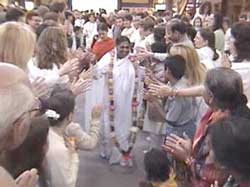
Wherever Amma travels in the world, the basic shape of Her programmes is the same: She generally arrives by car, stops briefly at the entrance to the venue for the traditional Indian cultural greeting for respected persons (a pada puja and a garlanding), then walks down a central pathway lined with the people who have come to meet her. Upon reaching the front of the hall, She turns to greet the crowd and then, first having prostrated to the Divinity she sees in all of them, She takes her seat and begins the program: meditation or satsang.
The publicity always announces that Amma will give a program of meditation, satsang, bhajans, and then Darshan.
The publicity never, of course, mentions that she will arrive, nor that she will leave. Well, that is obvious; it goes without saying.
But as a matter of fact, for many devotees the arrival and the departure are favourite parts of Amma’s programs. Why?
Watch, and you will know:
First there is the anticipation: people stand near the door, and form an aisle all the way to Amma’s peetham (seat) or to the steps to the stage. Right near the door there is spread a lovely piece of cloth, perhaps silk, or a soft special carpet; beside this there is a tray with flowers and petals, a small container of sandal paste and another of red kumkum. There is a small vessel of water—in November in Europe and America, it will be by some fortunate person’s cradling it in loving hands and keeping it close to the heart—for washing Mother’s feet. On the opposite side of the cloth or carpet will wait another member of the welcoming party, carefully holding ready a garland she or he has helped prepare for this special ritual. All around, softly, there will be the murmuring of a mantra: Om Amriteshwaryai Namah. It is a slow chant, and the atmosphere grows quiet and peaceful; minds are tuned to the reality that soon Amma will come.
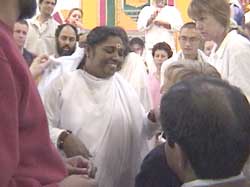
There is someone outside the hall, watching for the car. It is sighted, a signal is given, and inside everyone knows Amma is almost here because the pace, the pitch and the volume of the chanting suddenly increase. The car pulls up close; someone opens the door, and Mother steps out. The first thing She does is to bend and touch the ground; She glances around as She begins to cover the few yards to the doorway: there is someone in a wheelchair, and She bends to kiss him; here is a child holding a stuffed dragon in one hand and a flower in the other: She pats her head, or perhaps suddenly scoops her up into Her arms and moves forward. Just inside the door, She pauses, and the people granted this cherished opportunity perform the pada puja. She stands still, simple, humble, Her hands folded (unless the child She lifted has remained in Her embrace, as occasionally happens!). Her eyes are closed, Her head slightly inclined downwards. The ritual ends with an arati, and already She is scattering petals—perhaps She has plucked them from the garland just placed around Her neck, or perhaps they come from a plate of petals someone has held near. Amma showers these blessings on the heads of those who were involved in the ritual, and then perhaps tousles the hair of one and teasingly pinches the cheek of another; solemnity is not a requirement despite the reverence embodied in the pada puja. Mother sees someone off to the side a little, and hurls some petals at the unsuspecting target. Chortles of delight from Mother, when the surprised recipient suddenly tries to catch the well-aimed prasad.
Amma begins the trek to the front of the hall, and what began as a wide aisle becomes at best a narrow passage. Everyone wants a touch, a smile, a pat, a glance. Mother cannot be said to process to the stage. She walks among Her children, pausing to question this woman, to pat the bald head of that man, to kiss (and perhaps offer Her cheek for a kiss from) a child in someone’s arms. She reaches back the depth of three people to touch a yearning (and now startled!) man who had given up hope of contact.
This is how it is all the way to the front: Mother’s laughter and smiles, Her children’s delight.
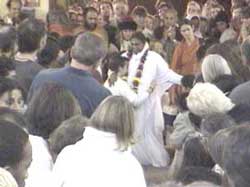
Amma arrives at Her peetham, steps up the couple of inches onto it, looks out over Her children, raises Her hands above Her head in the greeting one gives to one’s superiors—for Her children embody God and then kneels and bends to touch Her forehead to the carpet. For those who see Amma as an embodiment of the Universal Mother, or as a Mahatma or as a saint, this humble gesture is a graceful reminder that God is the Servant of all.
Then there is the program, as promised.
And then there is the departure.
You couldn’t call Amma’s arrival a processional, and neither can you call Her departure a recessional. She has been sitting perhaps for six or eight or ten hours, hugging, counseling, joking, consoling. The rest of us have probably left the hall for a meal or at least a snack and a cup of coffee, and probably a visit to the rest room as well. She has been only sitting, embracing, and blessing. Wouldn’t you think enough is enough and She might make Her way swiftly to the waiting car? You’d be mistaken.
She starts to stand, sees a few hesitant people off to the side, devotees who refrained from Darshan today because they saw the size of the crowd, and wanted to spare Her body. She makes eye contact, gives a quick nod of Her head, stretches Her arms out, and sits back down for another few hugs. Then She really does stand, but She doesn’t walk far, because the woman kneeling nearby is irresistible and Amma draws her close, pressing her head to Her stomach, stroking her hair, and at the same time calling out a teasing scolding to the young man just beyond them who hasn’t, after all, stopped smoking.
There is an ashramite standing nearby now, holding a tray of prasad. Mother takes a Hershey’s Kiss (that’s the traditional sweet for the American tours…Kisses and Hugs, naturally). She presses the foil-wrapped chocolate into the hand of the girl in Her embrace. Then Her hand goes right back to the tray and closes around at least a dozen more Kisses!
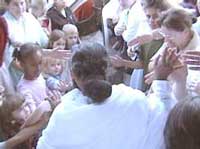
She begins to make Her way towards the exit, calling out “No Darshan people!”Those who didn’t have Her hug today stretch their hands out towards Her, and into each open hand She drops a chocolate. There is an effort on the part of the line monitors to get “no Darshan people” all to move to one side, but of course it generally doesn’t really work because Mother Herself keeps turning and reaching in either direction! There is a cheeky devotee who holds his hand out for a sweet only to have Mother laugh and scold him: “No second time!” Everyone else laughs as well, but inside some are asking themselves, “Now, out of all the people She hugged today, how can She remember this one?”
The handing out of prasad is only one task; Mother always likes to do several things at a time, so though She continues dropping chocolates into open hands as She makes Her way to the door, She also manages to stop and play with a baby, refusing to move further till he kisses Her not once but three times on the cheek!
She moves along a few steps and pauses to ask one of her sons how his hospitalized wife is doing; a few more steps and She pinches a teenager playfully, giving instructions in clear English: “Study, study!”. More steps along the way and a woman who has been crying finds a soft brown hand wiping her tears and caressing her cheek for a brief moment. A six-year-old child escapes her mother’s grip, barrels down the aisle and hurls herself against Mother’s knees. “I love you!” the girl shouts, and Amma grabs her shoulders, playfully shoves her away and pulls her back a few times. Just before the door, almost where the pada puja happened when She arrived, there waits someone with Her shoes.
This is usually a bald or balding man; Amma likes to drum playfully on a bald pate while its owner is coaxing Her to step into Her shoes. Actually, there are no rigid requirements about either baldness or gender; whoever the lucky man or woman is, he or she ends up with a special darshan as Mother, hugging (and maybe drumming!), stands a while, gazing around at all Her children so reluctant to see Her leave. Perhaps She chats a little more with some of the Malayalam speakers near the door before She exits.
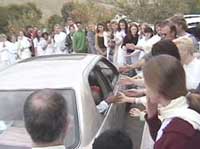
Is it over? Not quite. The distance from the door to the car requires a few more pieces of candy, some more touches and glances…and at the end, a final hurdle: to get through the press of little children around the car door, calling out “Amma, take me!” and “May I ride with You, Amma?” and “Please, Mother!” She squeezes past, sits in the car, looks back at the little ones, and sometimes relents: at such a time, She scoots over and calls one or two or perhaps even more into the back seat with Her; all cuddle close for the ride to the house.
Whether the children manage to hitch a ride or not, once the car door is closed, the window almost always opens, and Mother’s small hand stretches out. Slowly the car inches away from the curb and—here in San Ramon—heads down the hill. There is a sort of undulation in the line of people as Mother’s children, big and small alike, lean forward to touch Her fingers as She passes, and then step back.
At the bottom of the hill, the car still doesn’t speed up, because the kitchen crew has come out to have a glimpse of Amma—perhaps their only one this day—and She wants to touch them as well. “Seva, seva,” She calls out approvingly; their selfless service pleases Her, the Servant of all.
At last the car speeds up, people watch till it is beyond the gate and then around the bend. They trek back into the empty hall for their bags and blankets and folding chairs.
Empty hall; full hearts.
